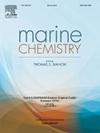Benthic biogeochemical processes and fluxes in the hypoxic and acidified northern Gulf of Mexico (nGoM), part I: Carbonate dissolution from in situ microprofiles
IF 2.5
3区 地球科学
Q2 CHEMISTRY, MULTIDISCIPLINARY
引用次数: 0
Abstract
The northern Gulf of Mexico (nGoM) experiences seasonal coastal hypoxia due to nutrient enrichment from the Mississippi-Atchafalaya River basin, leading to one of the world's largest hypoxic zones. In these shallow zones, benthic processes play an essential role in driving/maintaining deoxygenation and acidification of bottom waters. In this regard, this paper investigates carbonate dissolution processes in surface sediment of the nGoM during hypoxic conditions in summer 2022, as the main acidification feedback mechanism, with a specific focus on the effects of bottom water acidification. A strong linear relationship is observed between oxygen and pH, with a pH difference of 0.37 between the most oxygenated and the nearly anoxic station, reaching a value of 7.63. Using high-resolution techniques, this study combines pH and O₂ microprofiling (200 μm) with benthic measurements of carbonate system parameters (pH, DIC, TA, Ca2+) to assess carbonate dissolution at millimeter-scale resolution. The pH microprofiles reveal a significant decrease in the first 3 cm, with pore water pH reaching values of 6.90 at the most hypoxic station. Despite undersaturation with respect to aragonite and occasionally calcite, Ca2+ profiles indicate no significant carbonate dissolution, suggesting stability of calcium carbonate in these sediments during the summer. This lack of dissolution, likely influenced by the absence of aragonite, and possible inhibitory effects of dissolved organic carbon and orthophosphate, points to a limited buffering capacity in these sediments. These insights are essential for refining models predicting coastal acidification and hypoxia responses to environmental stressors in the nGoM and similar eutrophic systems.
缺氧和酸化的墨西哥湾北部底栖生物地球化学过程和通量,第一部分:原位微剖面的碳酸盐溶解
由于密西西比-阿恰法拉亚河流域的营养物质富集,墨西哥湾北部经历了季节性的沿海缺氧,导致了世界上最大的缺氧区之一。在这些浅水区,底栖生物过程在驱动/维持底水脱氧和酸化方面起着至关重要的作用。因此,本文研究了2022年夏季低氧条件下nGoM表层沉积物中的碳酸盐溶解过程,作为主要的酸化反馈机制,重点研究了底水酸化的影响。氧与pH之间存在很强的线性关系,最富氧站与几乎缺氧站的pH值相差0.37,达到7.63。利用高分辨率技术,本研究将pH和O₂微谱(200 μm)与碳酸盐系统参数(pH, DIC, TA, Ca2+)的底栖测量相结合,以毫米级分辨率评估碳酸盐溶解。pH微剖面在前3 cm显著降低,最缺氧站孔隙水pH值达到6.90。尽管文石和方解石处于欠饱和状态,但Ca2+剖面显示没有明显的碳酸盐溶解,这表明这些沉积物中的碳酸钙在夏季具有稳定性。这种溶解的缺乏,可能受到文石缺乏的影响,以及溶解的有机碳和正磷酸盐可能的抑制作用,表明这些沉积物的缓冲能力有限。这些见解对于改进预测nGoM和类似富营养化系统中环境压力源的沿海酸化和缺氧反应的模型至关重要。
本文章由计算机程序翻译,如有差异,请以英文原文为准。
求助全文
约1分钟内获得全文
求助全文
来源期刊

Marine Chemistry
化学-海洋学
CiteScore
6.00
自引率
3.30%
发文量
70
审稿时长
4.5 months
期刊介绍:
Marine Chemistry is an international medium for the publication of original studies and occasional reviews in the field of chemistry in the marine environment, with emphasis on the dynamic approach. The journal endeavours to cover all aspects, from chemical processes to theoretical and experimental work, and, by providing a central channel of communication, to speed the flow of information in this relatively new and rapidly expanding discipline.
 求助内容:
求助内容: 应助结果提醒方式:
应助结果提醒方式:


